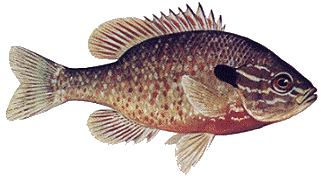REDBREAST SUNFISH: [Bream]
(Lepomis auritus). The golden brown sides have blue streaks and
pale red spots. The black ear flap is as long as that of a longear sunfish,
but it does not have a light-colored margin. The redbreast is named for
the male's orange-red breast. Males also have olive-colored upper sides
and blue streaks on on the cheeck. Females are less colorful, with pale
red to yellowish breasts.
Native to the Atlantic Coast states and as far north as New Brunswick,
redbreasts have been stocked in many southern states. The redbreast is also
called the yellowbelly sunfish, robin, redbelly and bream. Although the redbreast
is one of the smaller sunfish species, it has white, flaky, sweet-tasting meat,
much like that of the bluegill.
 HABITAT:
HABITAT:
Redbreasts are found mainly in streams along coastal plains and can
tolerate slightly brackish water. They prefer deep, slowing moving areas of
clear streams, with boulders, logs, weedbeds or undercut banks for cover. They
will not hold in fast current. They also live in lakes, reservoirs and ponds,
particularly those with moderate weed growth. Redbreasts favor warm water,
from 80 to 85 degrees F.
FOOD HABITS:
Common goods include aquatic and terrestrial insects, snails,
crayfish and small fish. [Tying instructions for all of these are found
in either the Fly of the Week archives
or Fly Tying Archives.]
Redbreasts are more prone to night feeding than other sunfish.
Primarily bottom feeders, they will also take food on the surface.
SPAWNING HABITS:
Redbreasts spawn in late spring or early summer, usually
at water temperatures from 66 to 70 degrees F, but sometimes
at temperatures as high as 82 degrees. Males build nests on sand-
gravel bottoms, generally near stumps, logs and rocks. They guard
the nest until shortly after the fry hatch.
AGE & GROWTH:
Compared to most other sunfish, redbreasts are slow-growing.
They grow fastest in the South, but even there, they reach only
about 1/3 pound in 6 years. They seldom live beyond age 7. The
world-record redbreast weighed 2 pounds, 1 ounce and was caught
in the Suwannee River, Florida, in 1988. There is no fly rod record.
|

